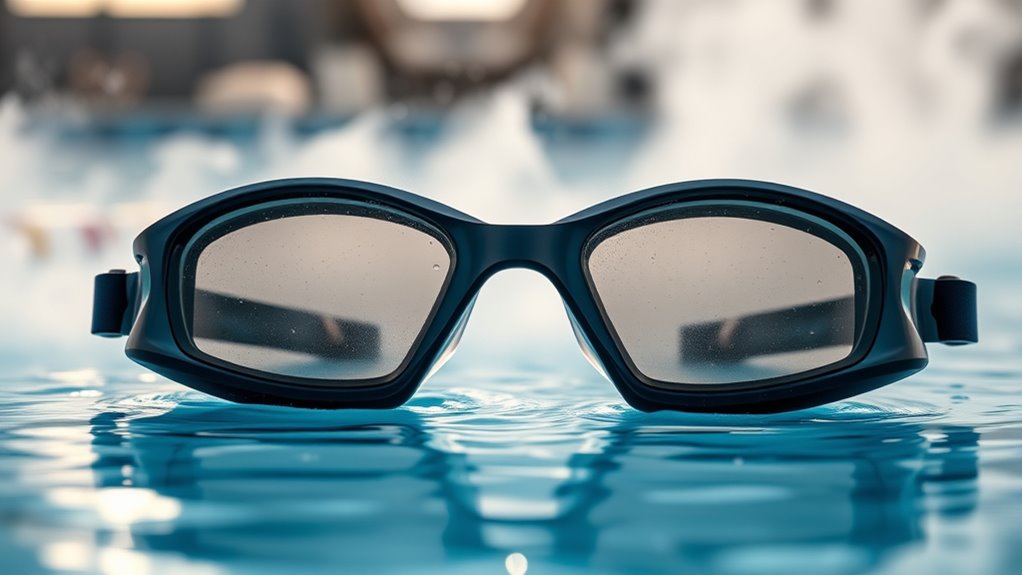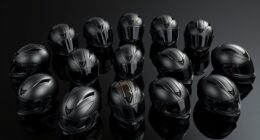To prevent your goggles from fogging in warm pools and cool air, apply an anti-fog coating during manufacturing or use a spray or gel before swimming. Rinsing goggles with water close to the environment’s temperature helps prevent sudden temperature changes that cause fog. Natural agents like saliva can offer temporary relief. Managing temperature differences and maintaining your goggles with proper cleaning will keep your vision clear. Keep going to discover more tips on staying fog-free.
Key Takeaways
- Anti-fog coatings reduce surface tension, promoting even moisture spread and preventing droplet formation on goggles.
- Rinsing goggles with water matching ambient temperature minimizes temperature differences that cause condensation.
- Regular cleaning with gentle soap maintains the integrity of anti-fog coatings for consistent clarity.
- Applying anti-fog sprays or gels creates a temporary barrier against fogging, especially useful in variable environments.
- Managing environmental factors like moving from warm pools to cooler air helps prevent sudden fog formation on goggles.

If you’ve ever experienced fogged-up goggles during a vital moment, you know how frustrating it can be. The sudden blur obstructs your vision, making it difficult to see clearly and hampering your performance. Whether you’re swimming in a warm pool or charting a course through chilly air, fog buildup is a common problem that can ruin your focus and confidence. Luckily, understanding the science behind anti-fog technology can help you stay clear and confident in any environment.
Fogging occurs when warm, moist air hits a cooler surface like your goggles. As your body exhales or water naturally evaporates inside the goggles, the moisture condenses on the cooler lens surface, creating tiny water droplets that scatter light and obscure your view. This process is accelerated in warm pools because the higher temperature causes more moisture to evaporate, while in cooler air, rapid temperature differences intensify condensation. The key to preventing this fog is managing the surface tension of water and reducing the temperature gap between the lens and your environment.
Manufacturers have developed various anti-fog solutions to counteract this effect. Most goggles come with a special coating applied during manufacturing, which works by filling in tiny imperfections on the lens surface. This coating reduces the surface tension of water droplets, causing moisture to spread evenly into a thin, transparent film rather than forming foggy droplets. When you look through the lens, this film allows light to pass through smoothly, maintaining clear vision. To keep this coating effective, it’s essential to clean your goggles with gentle soap and water regularly, avoiding harsh chemicals that can strip the anti-fog layer.
Another effective method is applying a small amount of anti-fog spray or gel, which you can buy separately. When you apply it, make sure to spread an even layer across the inside of the lens and let it dry before use. This creates a temporary barrier that suppresses condensation. Remember, reapplication is often necessary, especially after swimming or wiping the goggles clean. Additionally, some swimmers swear by simply rinsing goggles with a bit of saliva or water before diving in—they act as natural anti-fog agents because they introduce a thin, lubricating film over the lens surface. However, these methods are temporary and less reliable than commercial solutions.
In environments with fluctuating temperatures—like moving from a heated pool to a cooler air-conditioned space—your goggles may fog more easily. To combat this, try to acclimate your goggles by rinsing them with water of similar temperature to your environment before use. This minimizes the temperature difference that causes condensation. Ultimately, understanding these simple principles and using the right products will help you keep your goggles fog-free, so you can focus on your swim or activity without interruption. Additionally, being aware of environmental factors can help you better manage fogging issues in different conditions.
Frequently Asked Questions
Can Anti-Fog Coatings Harm My Skin or Eyes?
Anti-fog coatings are generally safe for your skin and eyes when used as directed. They’re designed to stay on the goggles’ surface, not to come into contact with your skin or eyes. However, if you notice irritation or discomfort, you should rinse your eyes or skin thoroughly and stop using the product. Always follow the manufacturer’s instructions and avoid ingesting or inhaling the coating to prevent any potential risks.
How Long Do Anti-Fog Treatments Last Naturally?
Anti-fog treatments typically last between a few days to a week, depending on how often you use and clean your goggles. If you rinse them with water or wipe them gently after each swim, the coating stays effective longer. Avoid harsh chemicals or scrubbing, as they can wear down the treatment faster. Reapplying anti-fog solutions regularly guarantees your goggles stay clear and fog-free during every swim.
Are There Eco-Friendly Anti-Fog Options Available?
Yes, eco-friendly anti-fog options are available. You can choose biodegradable sprays or wipes made from natural ingredients like plant extracts and essential oils, which are safe for both you and the environment. These alternatives work effectively without harmful chemicals, making them a great choice if you’re eco-conscious. Always check product labels for eco-friendly certifications to guarantee you’re selecting sustainable options that won’t harm aquatic life or pollute waterways.
Can Anti-Fog Sprays Be Used on Prescription Glasses?
Yes, you can use anti-fog sprays on prescription glasses, but you need to select the right product. Look for sprays labeled safe for eyewear and avoid those with harsh chemicals. Apply a small amount to your lenses and gently buff with a microfiber cloth. Test a small area first to verify it doesn’t damage your lenses or coatings. Always follow the manufacturer’s instructions for the best results.
How Do Temperature Changes Affect Anti-Fog Effectiveness?
Temperature changes can greatly impact anti-fog effectiveness. When you experience a rapid shift from warm to cool air or vice versa, your goggles or glasses may fog up as moisture condenses. To minimize this, make sure your lenses are clean and apply anti-fog solutions properly before temperature shifts. Keep your environment as stable as possible, and avoid touching the lenses, which can smudge and reduce anti-fog performance.
Conclusion
Now that you know how anti-fog science works, you can enjoy clear goggles no matter the conditions. Did you know that some anti-fog coatings can last up to six months with proper care? That means fewer interruptions during your swim or dive, and more time enjoying your activity. So next time you’re in a warm pool or cool air, remember these simple science tips. Clear vision makes all the difference—dive in with confidence!










